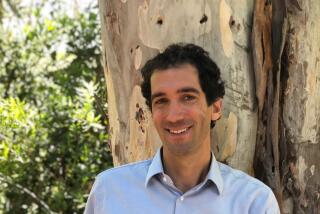A bold observer
“The kind of creatures I sought were quite different. [I only wished to study] the generation, reproduction and transformation of the creatures, how one emerges from the other, [and] the nature of their diet. . . . Therefore, I would ask you to be so kind and not to send me any more [dead] creatures, for I have no use for them.”
--
THE QUOTE above, attributed to 17th century German painter Maria Sibylla Merian and emblazoned on one wall of the Getty Museum’s current exhibition of her work, refers to the artist’s primary subject and lifelong passion: insects -- namely, caterpillars, moths and butterflies.
She collected them, observed them, sold them to other collectors, traveled as far as South America to research them, dissected them and, most important, painted them, publishing several books of the images over her lifetime. When she began her work, it was generally believed that insects were the spawn of the devil, generated by bad meat and rotting fruit -- few had looked closely enough to prove otherwise. Merian’s work helped to dispel that illusion.
That none of her activities would have been considered the least bit ladylike is, of course, one of the underlying pleasures of this affectionate survey, which was organized in conjunction with the Museum Het Rembrandthuis in Amsterdam. A small but satisfying compensation for centuries of oppression and inequality is the emergence of stories of this sort, about women of talent, intelligence and audacity who cut their own paths under circumstances considerably less auspicious than our own.
Merian came from a middle-class family of publishers. Her father died when she was 3, and it was her stepfather, a still-life painter, who encouraged her own painting habit, against her mother’s wishes. She married at 18, gave birth to two daughters and published her first book -- “The New Book of Flowers” -- at 28. She left her husband 10 years later, moving first to a religious community in the northern Netherlands, then to Amsterdam, where she supported herself and her daughters by selling her work along with art supplies and mounted insects, preserved animals and other naturalist paraphernalia. At 52, she traveled with her youngest daughter to the Dutch colony of Suriname and spent two years documenting the fauna and flora of that “hot, wet land” in northeastern South America to produce what the exhibition refers to as her magnum opus: “The Metamorphosis of the Insects of Suriname.”
The show contextualizes Merian’s career with examples of paintings by her two daughters, who worked alongside their mother throughout her life and nurtured her legacy after she died in 1717, as well as by numerous contemporaries, including her stepfather and other teachers. It also includes a variety of actual specimens mounted alongside Merian’s indeed very accurate depictions.
The paintings themselves will strike few as revolutionary. To a contemporary eye, in fact, they are the stuff of notecards and teacups -- an association that’s only confirmed by the inclusion, in the exhibition’s press packet, of a separate release announcing: “Getty Museum Exhibition of the Work of Maria Sibylla Merian Inspires Unique Gift Items.” This isn’t necessarily a bad thing: They’re lovely paintings, and judging from the images on that release, they make for lovely dinnerware (if you don’t mind the occasional caterpillar in the bottom of your soup).
The lasting distinction of this exhibition, however, lies in Merian’s extreme diligence of observation -- and in the understanding the show engenders of how radical, or at least liberating, such a quality would have been in Europe at that time. It was an era of tremendous transition, which saw science, religion and art locked in a state of muddled and sometimes violent agitation. Descartes published his “Discourse on the Method” (“I think, therefore I am”) in 1637, a decade before Merian’s birth. The Protestant Reformation came to a close in 1648, a year after she was born. Isaac Newton was only a few years Merian’s senior and published the “Philosophiae Naturalis Principia Mathematica,” outlining his three universal laws of motion, in 1687.
Merian herself was a Calvinist, according to the show’s exhaustive (though loosely written and often confusing) catalog, and saw her work as an extension of her faith: an investigation of God’s world. As that quote on the wall suggests, she was fascinated with life: with its forms, its mechanisms, its processes. Her channel for this fascination was painting. In some sense, then, three monumental forces of her day -- religion, science and art -- come to equilibrium in these dainty, pleasant little pictures.
As she put it in another quotation displayed on one of the museum’s walls: “Art and nature shall always be wrestling until they eventually conquer one another so that the victory is the same stroke and line: that which is conquered, conquers at the same time.”
--
‘Maria Sibylla Merian & Daughters’
Where: J. Paul Getty Museum, 1200 Getty Center Drive, Los Angeles
When: 10 a.m. to 6 p.m. Tuesdays through Thursdays and Sundays; 10 a.m. to 9 p.m. Fridays and Saturdays
Ends: Aug. 31
Price: Free; parking is $8
Contact: (310) 440-7300 or www.getty.edu
More to Read
Sign up for our Book Club newsletter
Get the latest news, events and more from the Los Angeles Times Book Club, and help us get L.A. reading and talking.
You may occasionally receive promotional content from the Los Angeles Times.






